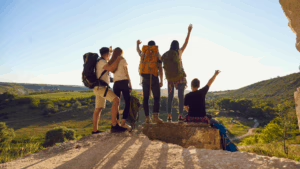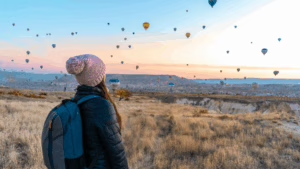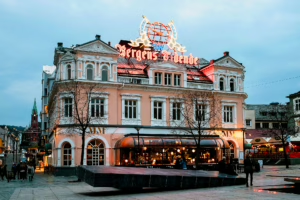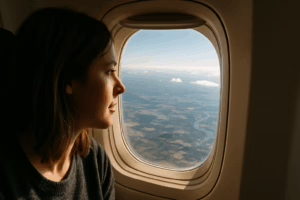A New Way to Experience Nature
Travelers seeking a break from city life often retreat to natural sanctuaries. However, today’s options offer more than the traditional rustic cabins. In northern Sweden, the Treehotel floats above the forest floor in Harads, blending modern architecture with Arctic wilderness. One of its most photographed rooms is the Mirrorcube, a structure wrapped entirely in mirrored glass, almost invisible among the trees. Designed by Tham & Videgård Architects, it is a reflection of how design and nature complement each other.
In Patagonia, EcoCamp Torres del Paine offers geodesic domes modeled after the traditional dwellings of the Kawésqar people. With composting toilets, solar panels, and panoramic windows that frame the jagged peaks of Torres del Paine, the camp combines ecological awareness with creature comforts. These types of accommodations offer more than a place to sleep, they create an intimate relationship between the guest and the environment.
A growing trend is eco-conscious travel. Eco-lodges, tree pods, and off-grid cabins are becoming more and more popular, especially for the younger generations.. According to a report by Booking.com, 83 percent of global travelers say sustainable travel is important to them. Lodging that includes the main aspect of shelter and rest, with sustainability, is being sought more and more.
Sleeping Inside a Story
Travelers are also looking to sleep in a place that gives a storybook feel. For example, in Cappadocia, Turkey, hotels carved into soft volcanic stone date back to ancient times. Modern cave hotels like Museum Hotel bring contemporary design to the architecture, creating suites with underfloor heating, antiques, and sweeping views of hot air balloons rising at dawn.
Meanwhile, Giraffe Manor in Nairobi, Kenya, feels like stepping into a Wes Anderson film. A 1930s mansion turned boutique hotel, it is famous for the herd of Rothschild giraffes that wander freely and frequently poke their heads through the breakfast room windows. The experience is surreal, yes, but also rooted in conservation; proceeds from stays help fund efforts to protect the endangered species.
These types of stays are built upon a narrative, one built on history, architecture, wildlife, or a dream realized. The setting becomes part of the narrative you take home.
Cultural Immersion Through Local Lodging
One of the most rewarding aspects of travel is the ability to step into someone else’s world—even if just for a night. Unique lodging rooted in culture offers travelers the chance to move beyond tourism and into something deeper: a glimpse of everyday life, tradition, and hospitality that no hotel chain can replicate.
In Japan, ryokans—traditional inns that date back centuries—provide an immersive cultural experience that blends tranquility and ceremony. Guests sleep on tatami mats, wear yukatas, and dine on seasonal kaiseki meals served with an almost meditative attention to detail. At Gora Kadan in Hakone, a former imperial family retreat turned ryokan, the mix of architecture, cuisine, and onsen bathing rituals offers a full sensory journey into Japanese heritage.
Across the world in Morocco, riads tucked behind unassuming doors in the heart of ancient medinas are designed around lush, tiled courtyards. Staying in a riad like Riad Farnatchi in Marrakech lets travelers experience the rhythm of Moroccan life—from calls to prayer echoing through the alleys to rooftop tea at sunset.
These culturally rich stays aren’t just beautiful—they’re deeply rooted in place. They offer access to traditions and hospitality passed down through generations, turning travel into a form of living history.
Sleeping Underwater—or Above the Clouds
The rise of experience-driven travel has led to a boom in architectural ambition. Hotels no longer just offer views of the ocean or skyline. Some now let you live inside them.
Take The Muraka, an underwater suite at the Conrad Maldives Rangali Island. Guests descend a spiral staircase into a glass-walled bedroom beneath the sea, where tropical fish drift past your window as you fall asleep. It’s one of the world’s first undersea residences—and at $50,000 a night, one of the most extravagant.
On the flip side, literally, there are sky-high escapes like Skylodge Adventure Suites in Peru’s Sacred Valley. These transparent pods cling to the side of a cliff, accessible only by zipline or a vertical climb. The reward: unmatched views of the Andes, and the kind of adrenaline-fueled peace only possible when you’re suspended 1,200 feet in the air.
These extreme lodgings aren’t just thrill-seeking stunts—they’re a sign of how architecture is pushing boundaries to deliver travel experiences that defy expectation and create once-in-a-lifetime moments.
Sustainable Stays with a Soul
Sustainability in lodging has moved beyond solar panels and towel reuse programs. The most innovative stays today are designed with intention from the ground up, embracing eco-conscious architecture, community integration, and regenerative design.
In Costa Rica, Finca Bellavista is a self-sustaining treehouse village deep in the rainforest, where each elevated home is built with reclaimed materials and connected by hanging bridges. Guests are invited to unplug, literally—there’s limited electricity—and reconnect with the natural world.
In South Africa, Emboo River Camp inside the Maasai Mara takes it a step further. It’s the first camp in the region to use electric safari vehicles, powered entirely by solar energy. The entire operation—water systems, food sourcing, waste management—is designed to have a circular impact.
These stays show that sustainability doesn’t have to feel like a compromise. In fact, it can enhance the travel experience, offering peace of mind along with natural beauty.
The Future of Lodging: Design Meets Experience
Design-led accommodations are becoming destinations in their own right. Forget bland hotel rooms. Today’s travelers seek emotion, aesthetic, and storytelling—something Instagrammable, yes, but also something soulful.
The Juvet Landscape Hotel in Norway, for example, is a stunning blend of architecture and environment. Its mirrored cubes and glass walls create the illusion of floating in nature. The hotel gained fame as a filming location for Ex Machina, but its real triumph is in how it erases the boundary between inside and out.
Then there’s Casa Tiny, a minimalist concrete hideaway in Oaxaca, Mexico, inspired by Henry David Thoreau’s Walden. Built for solitude and slow living, it’s just steps from the sea and surrounded by tropical vegetation. No Wi-Fi. No distractions. Just design, nature, and presence.
These properties aren’t just about amenities—they’re about how a space makes you feel. The lines between art, shelter, and storytelling continue to blur.
Sleeping Like an Astronaut: Space-Themed Stays
As space tourism inches closer to reality, earthbound travelers are getting a taste of the cosmos through imaginative space-themed lodging. These stays don’t just mimic the look of space—they immerse guests in an otherworldly narrative that bridges science, fantasy, and futurism.
Take the Galaxy Pod Hostel in Reykjavik, Iceland. Its capsule-style beds resemble sleeping pods on a spaceship, complete with glowing LED lights and interactive control panels. While it’s a budget-friendly option, the vibe is entirely sci-fi, ideal for aurora hunters who want to feel like they’re sleeping on another planet.
For something more immersive, the Kameha Grand Zurich in Switzerland offers a Space Suite designed by artist Michael Najjar, who is also a Virgin Galactic astronaut candidate. The room features zero-gravity beds, galactic murals, and lunar-inspired furnishings. It’s part luxury suite, part moon base—perfect for space enthusiasts with a taste for design.
Even desert locations have joined in. At Space Hotel in Wadi Rum, Jordan—where The Martian was filmed—guests sleep in bubble domes under the stars, surrounded by red sand and silence. It’s as close to Mars as you can get without leaving Earth.
These stays offer a sense of wonder and exploration, whether through design, setting, or science. As the line between fantasy and reality blurs, space-themed lodging invites guests to imagine the future while appreciating the alien beauty of our own planet.
Where Art Meets Accommodation
Some lodging isn’t just a place to stay—it’s a gallery, a canvas, a museum come alive. Art-integrated accommodations blur the line between creative expression and shelter, offering an immersive, often participatory, experience for guests.
Take 21c Museum Hotels, a boutique chain across the United States that merges luxury hotel service with rotating contemporary art exhibitions. Guests can explore curated installations in hallways, lobbies, and even elevators—each visit offers something new, and each location reflects its city’s cultural identity.
In Berlin, the Arte Luise Kunsthotel offers a stay inside a living art exhibit. Every room is designed by a different artist, from surrealist dreamscapes to pop art explosions. No two rooms are alike, and that’s the point. Guests choose their aesthetic adventure based on the mood they want to inhabit.
Similarly, the Hôtel des Arts in San Francisco gives over entire rooms to local street artists. Murals crawl across ceilings, installations hang from unexpected corners, and every stay supports the city’s creative community. Art here isn’t passive—it’s the whole experience.
These accommodations invite guests to sleep inside creativity. You don’t just look at art—you live with it. Whether it’s visual, conceptual, or immersive, art-integrated stays allow travelers to connect emotionally with a place through the language of imagination.
As global travel shifts toward personalization and meaning, these lodging options prove that where you stay can be as inspiring as the journey itself.
Why Travelers Are Choosing the Unexpected
So why the shift toward unique lodging? The answer is simple: people want to feel something. They want novelty, meaning, and memories that stick.
In a post-pandemic world, where remote work and flexible schedules have changed how—and why—we travel, lodging has evolved to meet a new kind of desire. Travelers aren’t just booking stays—they’re curating experiences.
As boutique booking platforms like Unique Stays, Unyoked, and PlansMatter grow, it’s clear the demand is more than a trend. It’s a movement toward personalized, experience-driven, often sustainable travel that resonates with the modern explorer.
TLDR: Best Unique Lodging Around the World
- Treehotel in Sweden: Forest immersion meets design in mirrored treetop suites.
- EcoCamp in Patagonia: Geodesic domes offer sustainability and scenery.
- Museum Hotel in Turkey: Cave dwellings reimagined with luxury and history.
- Giraffe Manor in Kenya: Live among giraffes in a colonial-style manor.
- Gora Kadan in Japan: Traditional ryokan experience with imperial roots.
- The Muraka in the Maldives: Sleep below sea level in a glass-walled suite.
- Skylodge in Peru: Cliffside pods for adventurous souls.
- Finca Bellavista in Costa Rica: An off-grid treehouse community in the jungle.
- Juvet Hotel in Norway: Sleek architecture built into the natural landscape.
- Casa Tiny in Mexico: Minimalist design meets tropical seclusion.
- Galaxy Pod Hostel in Iceland: Futuristic capsules in the land of the northern lights.
- 21c Museum Hotels (USA): Where every hallway is an art gallery.
















